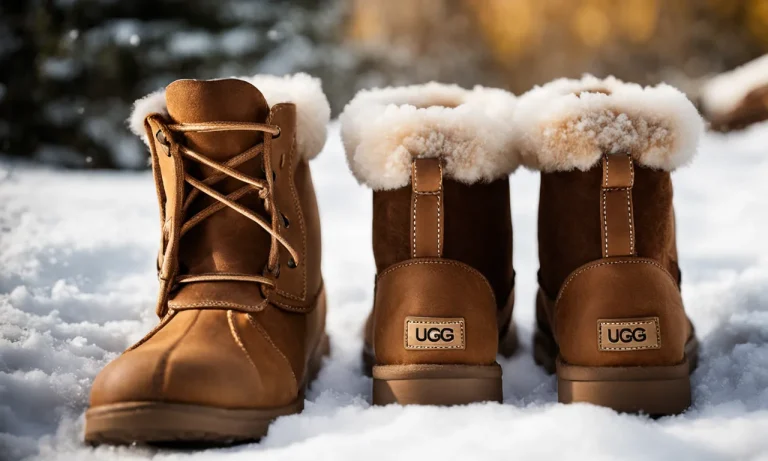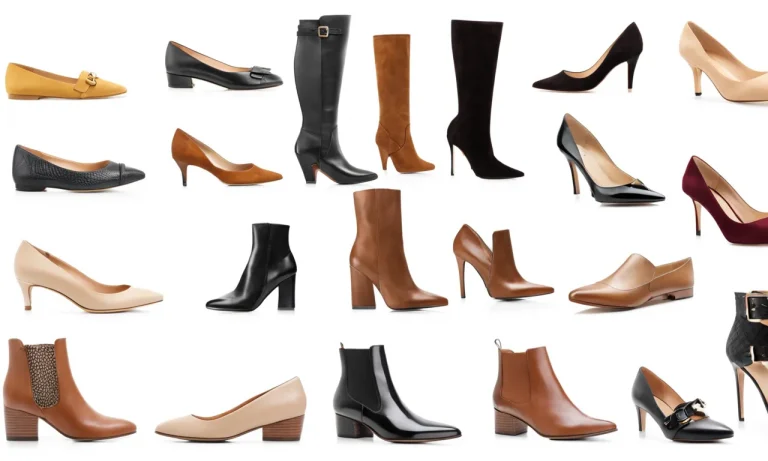Shoes come in all shapes and sizes, but do men and women use the same sizing systems? If you’ve ever tried on shoes of the opposite gender, you may have noticed some key differences. In this comprehensive guide, we’ll provide a detailed look at how men’s and women’s shoe sizes compare.
If you’re short on time, here’s a quick answer: Men’s and women’s shoes are not sized the same. Men’s shoes are generally about 1.5 sizes larger than women’s for any given foot length.
A Brief History of Shoe Sizing
Shoe sizing is an essential aspect of the footwear industry, ensuring that customers find the right fit for their feet. However, the concept of shoe sizing has evolved over time. Let’s take a brief journey through the history of shoe sizing.
The Origins of Shoe Sizing
The need for standardized shoe sizes arose as early as the 13th century when cobblers started crafting shoes for multiple customers. However, it wasn’t until the 18th century that shoe sizing systems began to emerge.
Instead of relying on standardized measurements, cobblers would use their own judgment and create shoes based on the individual’s foot measurements.
This lack of standardization led to inconsistencies in shoe sizes, making it challenging for people to find the perfect fit. It also made it difficult for shoe manufacturers to produce shoes on a larger scale.
The Development of Standard Sizing Systems
In the mid-19th century, various efforts were made to establish standardized shoe sizes. One notable development was the introduction of the Brannock Device in 1927, a tool that accurately measured foot length and width.
This device revolutionized shoe sizing and became widely adopted in the footwear industry.
Standardized sizing systems, such as the Mondopoint system and the European Shoe Sizing system, were also introduced to ensure consistency in shoe sizes across different countries.
When Sizing Differences Emerged for Men and Women
While shoe sizing systems aimed to provide a universal standard, differences in shoe sizes for men and women eventually emerged. Historically, women’s shoe sizes were generally smaller than men’s sizes due to anatomical differences between the sexes.
Today, most shoe brands follow a separate sizing scale for men and women, with women’s sizes typically ranging from 5 to 12 and men’s sizes ranging from 6 to 16. However, it’s important to note that shoe sizes can still vary between brands, so it’s always recommended to try on shoes before making a purchase.
Understanding the history of shoe sizing helps us appreciate the efforts made to ensure that we can find the perfect fit for our feet. So, the next time you go shoe shopping, remember how far we’ve come in providing standardized sizes for our footwear!
How Men’s and Women’s Shoe Sizes Are Measured
When it comes to measuring shoe sizes, there are a few key differences between men’s and women’s sizing. Understanding these differences can help ensure a proper fit and avoid any discomfort or pain when wearing shoes.
Measuring length vs width
One of the main differences in measuring men’s and women’s shoe sizes lies in how length and width are taken into account. Both men’s and women’s shoes are measured in length, but women’s shoes tend to have a narrower width compared to men’s shoes.
This is because women generally have narrower feet than men.
When determining shoe size, it is important to measure both the length and width of the foot. This helps ensure that the shoe provides a comfortable fit and allows for proper toe movement. It is recommended to have your feet measured by a professional at a shoe store to get the most accurate measurements.
Common sizing systems used today
There are different sizing systems used around the world, but two of the most common ones are the U.S. sizing system and the European sizing system. In the U.S., men’s shoe sizes typically range from 6 to 18, while women’s shoe sizes range from 4 to 14.
However, it is important to note that these ranges may vary depending on the brand and style of the shoe.
In the European sizing system, men’s shoe sizes typically range from 38 to 52, while women’s shoe sizes range from 35 to 44. Again, these ranges can vary slightly depending on the shoe brand.
Converting between men’s and women’s sizes
If you come across a shoe that is available in both men’s and women’s sizes and you need to convert between the two, there is a general rule of thumb you can follow. For men’s sizes, you typically need to subtract 1.5 from the women’s size to find the equivalent men’s size.
For example, if a woman wears a size 8, the equivalent men’s size would be 6.5.
However, it is important to keep in mind that this rule may not always be accurate for all shoe brands and styles. It is always best to consult the specific brand’s size chart or try on the shoes in person to ensure the best fit.
Key Differences in Foot Anatomy
When it comes to shoe sizes, many people wonder if there are any differences between men’s and women’s sizes. While the numerical values may vary, there are indeed key differences in foot anatomy between men and women that can impact the fit of shoes.
Comparing foot shapes and dimensions
Men’s and women’s feet differ in several ways. Generally, men’s feet tend to be wider and longer compared to women’s feet. Additionally, men’s feet typically have a higher arch and a narrower heel. On the other hand, women’s feet are often narrower in the forefoot area and have a wider heel.
These differences in foot shapes and dimensions can greatly influence how shoes fit and feel on the wearer’s feet.
How this impacts fit
The differences in foot anatomy between men and women can directly affect the fit of shoes. For example, a woman with a narrower forefoot may find that men’s shoes feel too wide and loose, while a man with a higher arch may struggle to find adequate support in women’s shoes.
It’s important to consider these variations when choosing the right shoe size and style.
Furthermore, the differences in foot anatomy can also contribute to different areas of discomfort or potential foot problems. For instance, women may be more prone to developing bunions due to the narrower forefoot and higher heels often found in women’s shoes.
On the other hand, men may experience issues with shoe width and arch support. Understanding these differences can help individuals make informed decisions about their footwear.
Accommodating gender differences in shoe design
To address the variations in foot anatomy, shoe manufacturers often design shoes specifically for men and women. While the numerical sizes may differ, these gender-specific designs take into account the differences in foot shape, width, and arch height.
Women’s shoes are typically narrower in the forefoot and have a higher heel, while men’s shoes often have a wider toe box and more arch support.
It’s worth noting that not all individuals will fit perfectly into the typical gender-specific shoe designs. Some men may have narrower feet that better align with women’s shoe styles, and vice versa. It’s important to prioritize comfort and fit above adhering strictly to predefined gender categories when selecting shoes.
For more information on foot anatomy and shoe fit, you can visit reputable websites such as American Podiatric Medical Association or OrthoInfo. These sources provide valuable insights and advice on how to choose the right shoes based on individual foot characteristics.
Tips for Finding the Right Fit
Trying on shoes in-store
When it comes to finding the perfect fit for your shoes, there are a few tips that can help you out. If you prefer to try on shoes in-store, make sure to measure both of your feet. Many people have one foot slightly larger than the other, so it’s essential to find the size that accommodates the larger foot comfortably.
Don’t be shy to ask for assistance from the store staff; they are trained to help you find the right fit.
Another tip is to try on shoes later in the day. Throughout the day, our feet tend to swell, so trying on shoes in the afternoon or evening can give you a more accurate fit. Walk around in the shoes to get a sense of how they feel. Pay attention to any areas of discomfort or tightness.
Remember, the right fit shouldn’t pinch or squeeze your toes or rub against your heels. It should feel comfortable and supportive.
Ordering shoes online
If you prefer the convenience of ordering shoes online, there are a few things to keep in mind to ensure you find the right fit. First, carefully read the sizing chart provided by the retailer. Sizes can vary between brands, so it’s important to know your measurements and compare them to the chart.
Consider reading customer reviews to see if the shoes run true to size or if they tend to run larger or smaller.
Some online retailers offer free returns or exchanges, which can give you peace of mind in case the shoes don’t fit as expected. If you’re unsure about the sizing, you may want to order two different sizes and return the one that doesn’t fit.
Remember to try on the shoes on a clean surface to avoid any damage that may impact the return process.
Finding unisex or gender-neutral options
In recent years, there has been a rise in unisex or gender-neutral shoe options, which can be a great choice for individuals who don’t fit into traditional men’s or women’s sizes. These shoes are designed to accommodate a wider range of foot shapes and sizes, providing a more inclusive fit.
When searching for unisex or gender-neutral options, look for brands that prioritize inclusivity and diversity. Many of these brands have comprehensive size ranges and provide detailed sizing information on their websites.
It’s always a good idea to measure your feet and compare them to the brand’s sizing chart to find the right fit.
Remember, finding the right fit is crucial for comfort and overall foot health. Whether you’re trying on shoes in-store or ordering online, taking the time to find the perfect fit will ensure you can walk confidently and comfortably in your new shoes.
Answering Common Questions
Can men wear women’s sizes, or vice versa?
One common question when it comes to shoe sizes is whether men can wear women’s sizes, or vice versa. The short answer is yes, but there are a few things to keep in mind. Women’s shoe sizes are typically smaller than men’s, so if a man wants to wear women’s shoes, he would need to go up a size or two.
Similarly, women who want to wear men’s shoes should go down a size or two. It’s also important to note that shoe sizes can vary between brands, so it’s always a good idea to try on shoes before making a purchase.
What about big and small sizes?
When it comes to shoe sizes, there are often questions about big and small sizes. Some people may have larger or smaller feet than the standard shoe sizes available in stores. In these cases, it can be challenging to find shoes that fit properly.
However, many brands offer extended sizes for both men and women. These sizes are specifically designed for individuals with larger or smaller feet. Additionally, some brands offer custom-made shoes, allowing individuals to get the perfect fit.
It’s always worth exploring these options if you have trouble finding shoes in your size.
Do kids’ sizes differ for girls and boys?
Parents often wonder if there is a difference between shoe sizes for girls and boys when it comes to children’s shoes. Generally, there is some variation in shoe sizes between genders. Girls’ shoe sizes tend to be slightly smaller than boys’ shoe sizes.
However, the difference is usually not significant until children reach their teenage years. Before that, most children can comfortably wear shoes labeled as unisex or for either gender. As always, it’s best to measure a child’s feet and try on shoes to ensure the proper fit.
Conclusion
While the sizing scales used for men’s and women’s shoes today are not identitical, there are ways to correlate between the two. Being aware of key differences in foot proportions can help ensure you find shoes with the right fit and comfort, whether shopping for yourself or someone else.
With a few insider tips, both men and women can confidently wear shoes sized for their gender. So next time you’re puzzled over size charts, remember that men’s and women’s feet are shaped differently – but with a little know-how, you can bridge the (shoe) gap.






